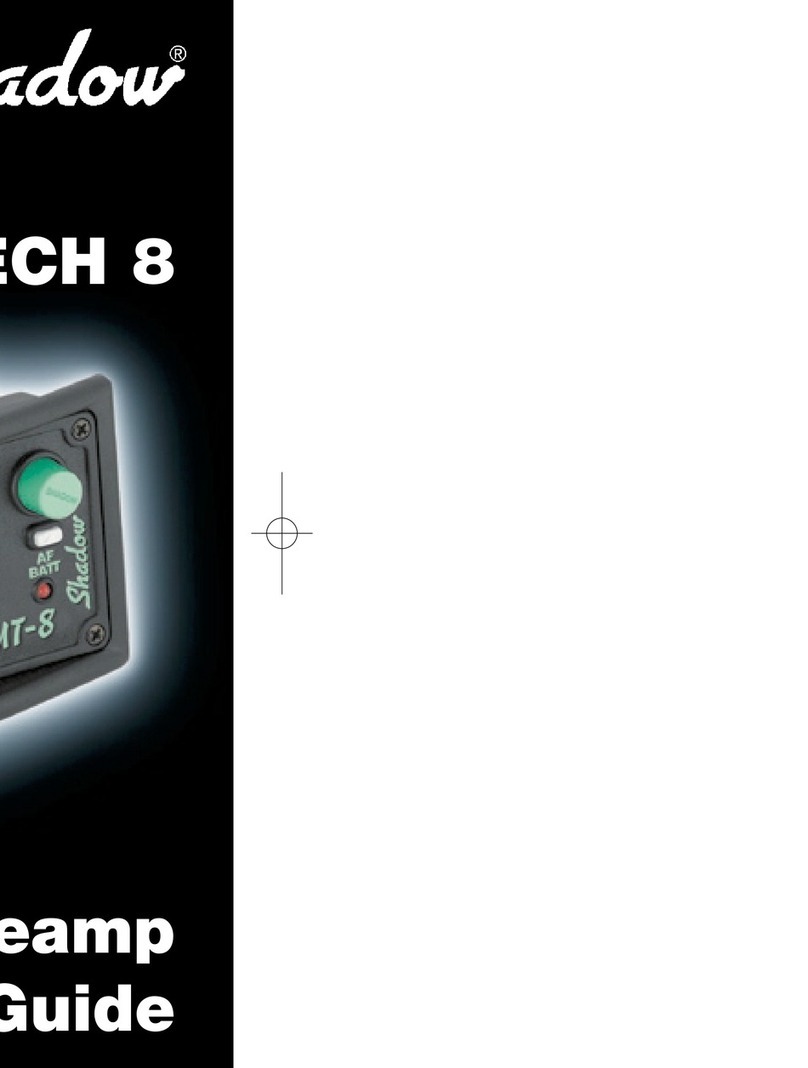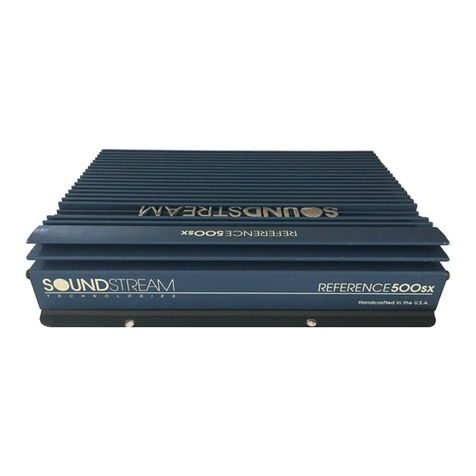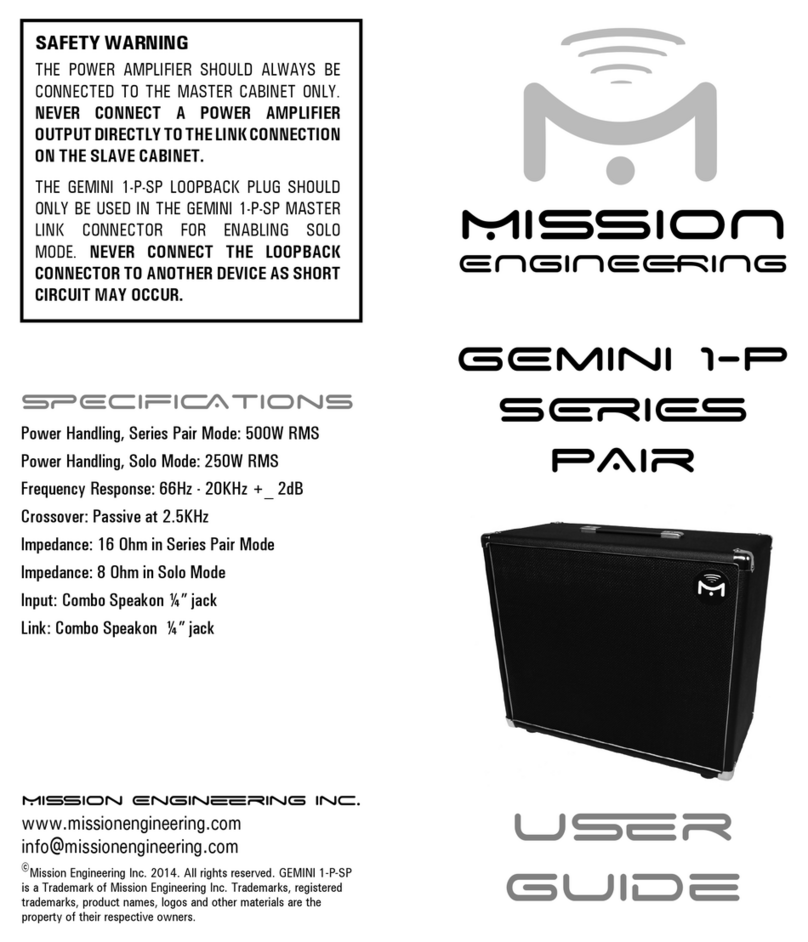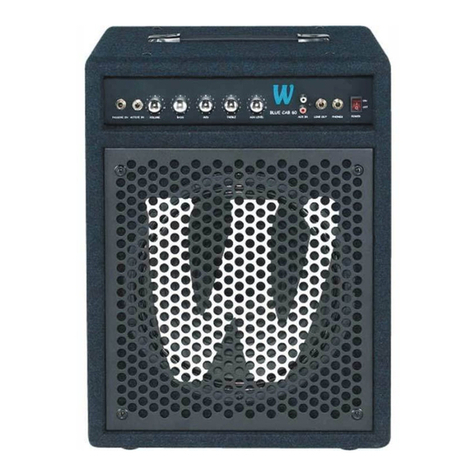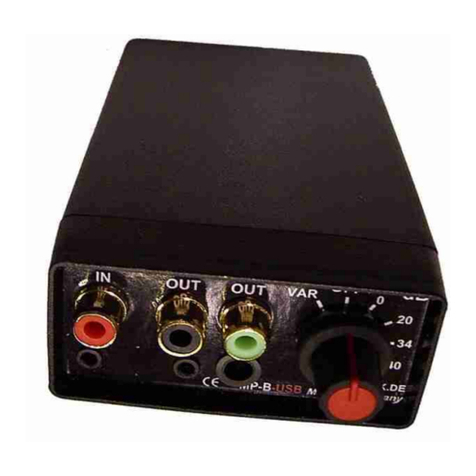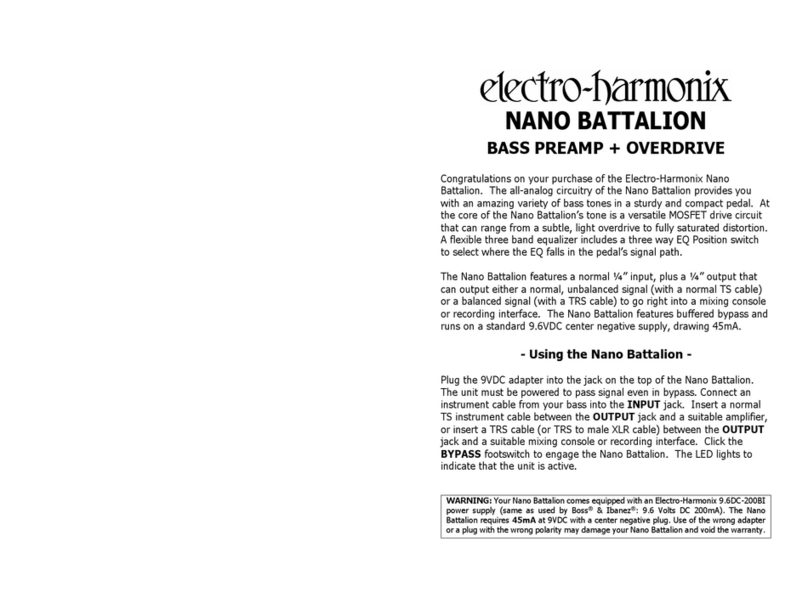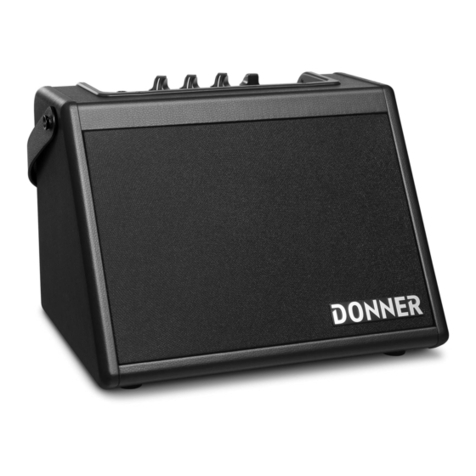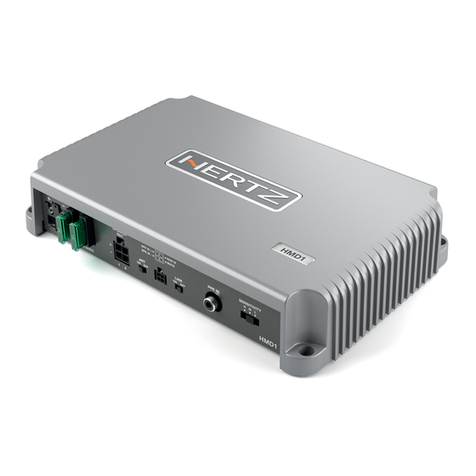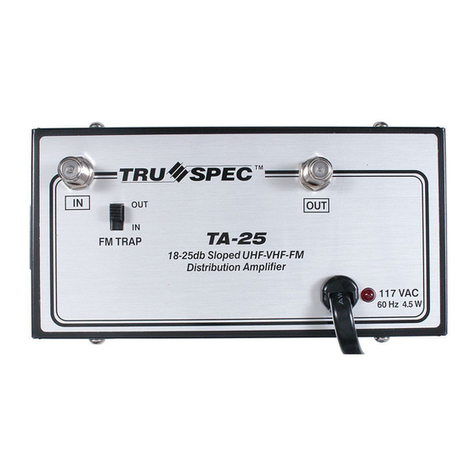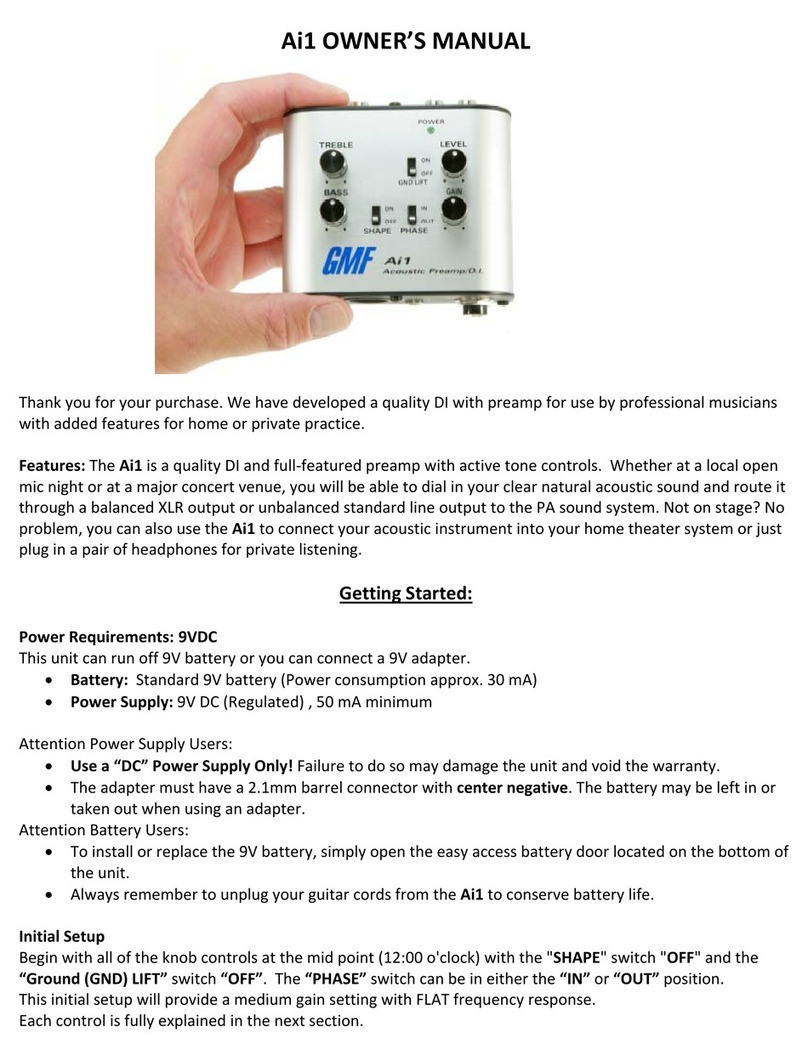Electronic Audio Experiments feT Technical manual

Technical Document
Model feT Manual
Version 2
Last Revised: 21-Oct-20
John Snyder

INTRODUCTION
Thank you for your purchase of the Electronic Audio Experiments Model feT! This
manual is an in-depth guide for properly using and enjoying your pedal.
The Model feT is my humble homage to the venerable Model T amplifier manufactured
by Sunn in the early 1970s. The original Model T was Sunn’s effort to compete with
Marshall –by borrowing the Super Bass design (itself a shameless re-iteration of the
Fender 5F6A Bassman) and adding their signature ultralinear power amplifier. This
power amp, inspired by Dynaco tube hi-fi equipment, produced a formidable 150W of
power with more clean headroom than the typical guitar amps of the time. Sunn was
short-lived in its success, but the Model T developed a cult following because of its
massive power output, deep bass response, and (in my opinion) its stark and imposing
aesthetic. In conjunction with down-tuned guitars, a kick from the right distortion pedal,
and enough patience to let a power chord feed back for 30 minutes, the amp redefined
the sound of heavy music.
The Model feT itself comes from a long line of “amp-in-a-box” pedals intended to
capture the sound of hard-to-find vintage amplifiers. The DIY pedal website
Runoffgroove popularized the notion that JFETs, a type of transistor, could be used to
emulate triode vacuum tubes (ironically, Sunn itself was early adopter of this practice in
the Concert Lead/Bass amplifiers). Because JFETs are what as known as “depletion
mode” devices, they may be biased in a manner akin to triodes. With allotments made
for standard pedal operating voltages, simply dropping JFETs into the schematic of a
tube amp can produce a convincing approximation of the amp in question. Without the
contributions of ROG, this project would likely not exist. However, this method is not
without limitations: JFETs do not perfectly mimic tubes, and many JFET amp
emulations do not include any references to power amps, despite the power amp being
critical to overdriven tones. A Model T pedal designed with this formula may suffer from
a thin, harsh sound lacking in headroom—a far cry from its namesake.
The Model feT widens this scope by including an emulated power amp, making it a
more complete emulation. After all, without an ultralinear power section, there is very
little distinguishing the Model T from a Super Bass or 5F6 Bassman. I also performed
thorough simulations to account for the subtle but critical differences between the
frequency response and impedances of JFETs versus triodes, which more accurately
reproduces the frequency response of the original amp. As a result, I believe this to be
the most accurate Model T reproduction in solid-state format.
The Model fet may serve as an overdrive pedal into an existing amp, as a preamplifier
going direct into a power amp (alternately into the effects return of an amp bypassing
the preamp), or even into a DAW running a cab simulation. In any of these applications

it is equal suited to clean or overdriven tones. As you turn up the gain controls, you can
go from the iconic “dirty clean” the Model T is known for all the way up to heavy rock
tones with deep bass extension. When the Model feT is set for lower gain, it shapes the
tone of other pedals stacked into it. At the end of a signal chain, it adds an entirely new
dimension to existing fuzzes, distortions, boosts, and even modulation or time-based
effects. When boosted the input stages provide their own overload, adding harmonic
content and deepening the amount of distortion in the same way a cranked amplifier
would with a loud pedal in front. Like the original Model T, the EQ curve is slightly mid-
scooped in just the right spot, lending heft to the lows and clarity to the highs that
enhances distortion and fuzz in front. The Model feT also has plenty of output level,
which makes the cleaner sounds as usable as the heavy ones and also allows for
overdriving an external tube power amp. With the Model feT, all the power and nuance
of a cult classic amp can be right at your feet.
Thanks for reading!
-John Snyder, EAE

OPERATION
Only use a standard, reliable 9VDC center-negative supply with the Model feT (e.g.
Truetone™, Voodoo Labs™, Strymon™, Cioks™, etc). The Model feT has a current
draw of 70mA with the effect engaged. Power supplies with AC output or a DC voltage
greater than 9V will risk damaging the pedal and voiding the warranty. The Model feT
does not and cannot use batteries.
The Model feT has soft-touch relay bypass switching with true bypass. The relay will
default to the bypass state in the event of power loss.
The Model feT may be used in various configurations, including:
•Standard pedal use: Model feT connected into an amplifier input, with or without
other pedals. Works as a straightforward overdrive in this configuration.
•Preamp with an existing amp: connect to the effects return/power amp input of
another amplifier. The Model replaces the existing preamp.
•Preamp with a power amp: connect to a dedicated power amp. Use a cabinet
properly designed for guitar or bass use. If using full range speakers, see below.
•Direct input: connect to a mixer or DAW input. For best results, use in
conjunction with an analog or digital speaker cabinet simulation.
Dialing in the Model feT for the first time is straightforward. Set all EQ knobs at noon,
Normal control at 12:00, and Brite and Master at minimum. Turn on the pedal, and
slowly bring up the Master until you reach the desired output level.
Depending on the output level of your instrument, you should have a light to medium
overdrive tone. Adjust the gain of the Normal channel as desired, and correct for
volume changes using Master if necessary. If you want more high-end bite or additional
distortion, turn up the Brite control to blend in that channel. The Brite channel may of
course be used on its own, though most users will find it thin-sounding without the
normal channel. The configuration is identical to a four-input amp on the “Hi” input with
the channels jumped.
The EQ is a standard FMV (Fender/Marshall/Vox) arrangement and should be familiar
to most guitarists, despite its idiosyncrasies. A couple notes on this EQ:
•It is a highly interactive EQ, so control settings will have an impact on each other.
For example, the Midrange control and Treble control overlap.
•Due to its placement in the circuit, it is more effective at lower gain settings, just
like how a cranked tube amp tends to overwhelm the EQ settings because of
power amp saturation.

•This tone stack is naturally scooped. In fact, the flattest response comes from
setting Bass at 0, Treble at 0, and Midrange at 10.
•The Treble control actually starts to increase bass content if it is turned
counterclockwise past 11:00 or so. Bass players and low-tuned guitarists may
find this helpful.
Note: The Model feT can get EXTREMELY loud so starting from zero is recommended
for new users. At higher gain settings, unity volume can be below 9:00. We gave this
pedal a lot of power at the output, so that clean tones may be dialed in without
sacrificing volume. Extremely high volume and gain settings can result in feedback with
some setups.

Stacking Pedals
The Model feT shines when working with other pedals. Place the Model feT after your
other pedals (at least boost/overdrive/fuzz), set the Model feT for a clean or low gain
tone, and then see what happens when other pedals are added. Here’s some we’ve
tried:
•Rangemaster style boost: works great using the Normal channel set to medium
gain, tightening it up for classic heavy metal tones
•Full range boost: can quickly overwhelm the input for a thicker, heavier sound
•Muff style fuzzes: go crazy, these work fabulously well. May need to use lower
output settings if the Model feT is set for high gain
•Fuzz Face style fuzzes: these also have lots of output, so to stack evenly keep
the fuzz level on the lower side
•Op amp distortions - the combination of even harmonics from an op amp drive
and odd harmonics from the Model feT can be devastating. Some of the best
Model T tones come from slamming it with a Proco Rat (or similar pedal)!
In conclusion…
The Model feT is far more than a soundalike overdrive for doom metal - it is a full
preamplifier and a powerful tool for both live and studio tone shaping. Thanks again!
CHANGELOG
Version 2
Manual release for Model feT V3.7
Version 1
Manual release for Model feT V3.0
www.electronicaudioexperiments.com
Table of contents
